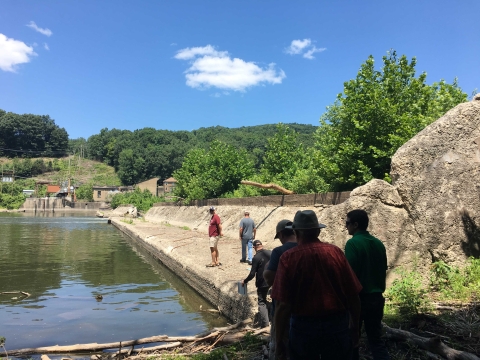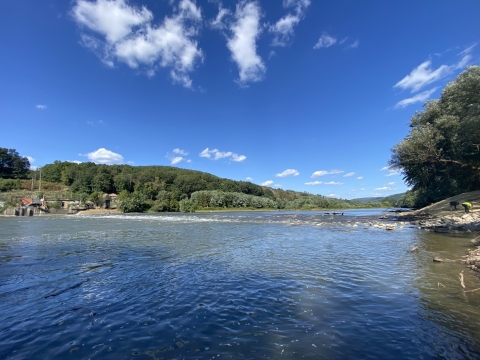Susquehanna River, 1929. A new-and-improved Oakland Dam is a marvel of modern engineering, measuring more than 755 feet long and 16 feet high. The dam would provide power to a nearby railroad depot and hospital for the next 60 years. Around 1990, however, the dam became obsolete; its capacity to produce hydropower was no longer cost-effective. Over time, the dam became hazardous to boaters and caused flooding upstream. On September 18, 2023, removal of the Oakland Dam marked the largest dam removal in Pennsylvania. Sportfish, recreationists, and nearby residents will benefit from the success of this project.
Preparing for the return of native fish
With the Oakland Dam gone, more than 250 miles of stream and aquatic habitats are reconnected, providing more places for sportfish, freshwater mussels, and other fish and wildlife to live and grow. For decades, the Service and our partners have been working together to restore migratory fish in the lower Susquehanna River. The removal of the Oakland Dam brings us closer to their return.
The rivers and streams of the Northeast once supported vast annual runs of fish species such as Atlantic salmon, American shad, and alewife, but during the past 200 years many of these populations have drastically decreased. Since 2009, the Service and our partners have removed more than 860 barriers to fish passage fish passage
Fish passage is the ability of fish or other aquatic species to move freely throughout their life to find food, reproduce, and complete their natural migration cycles. Millions of barriers to fish passage across the country are fragmenting habitat and leading to species declines. The U.S. Fish and Wildlife Service's National Fish Passage Program is working to reconnect watersheds to benefit both wildlife and people.
Learn more about fish passage and restored access to over 8,000 miles of rivers and streams throughout the Northeast.
Public safety
Failed dams pose a major risk to recreational users and the surrounding community. About a decade after the dam was retired and left abandoned, it developed a 110-foot breach which hid protruding rebar and concrete from view of river users. The remnants of the dam and the debris that became trapped was extremely hazardous to boaters. Then, record rainfalls in 2006 and 2011 caused flooding to neighboring communities living upstream of the dam. Even without the high rains, the water held above the dam was being forced through a narrow window at the site of the breach, making it pick up speed. This created a velocity barrier to many fish. The dam’s removal significantly decreases flood risks in this area, and boating hazards.
In addition to making the Susquehanna River safer for the community, the dam removal increases access to the waterfront and helps bolster economic growth. Indeed, the Susquehanna Borough Council can now move forward with their plans to create a new riverfront park on the south side of the river where people can camp. Thanks to our partners and funds from the National Fish Passage Program, the community can safely enjoy this section of the Susquehanna River.
The U.S. Fish and Wildlife Service contributed $100,000 from the National Fish Passage Program to the $450,000 project. The National Fish Passage Program improves community infrastructure resilience, rebuilds fish populations, improves recreational and commercial fisheries, and restores the beauty of free-flowing waters. We provide financial and technical assistance to support projects that improve fish passage.
Thank you to our partners who funded and supported removal of Oakland Dam. American Rivers, the Boroughs of Susquehanna and Oakland, Endless Mountains Heritage Region, Upper Susquehanna Coalition via Tioga County Soil and Water Conservation District, Pennsylvania Department of Environmental Protection, Pennsylvania Fish and Boat Commission, the U.S. Army Corps of Engineers, Pennsylvania Department of Conservation and Natural Resources, Pennsylvania Department of Community and Economic Development, River Bounty and Susquehanna County.





